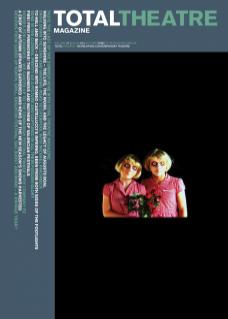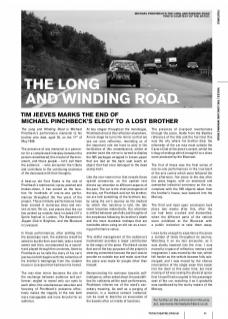The Long and Winding Road is Michael Pinchbeck’s performance memorial to his brother who died, aged 20, on the 17th of May 1998.
The presence of any memorial is a generator for a complicated interplay between the person remembered, the creator of the monument, and those people – let’s call them the audience – who encounter the tribute and contribute to the continuing existence of the deceased with their thoughts.
A beat-up old Ford Fiesta is the site of Pinchbeck’s testimonial; spray-painted and broken-down, it has served as the location for hundreds of one-to-one performances throughout the five years of the project. These intimate performances have been created in numerous sites and venues across the UK, and places that the car has parked up outside have included CPT’s Sprint festival in London, The Basement’s Supper Club in Brighton, and the Bluecoat in Liverpool.
In these performances, after settling into the passenger seat, the audience would be asked to buckle their seat-belt, take a travel sweet and then, accompanied by a soundtrack played through the car stereo, listen to Pinchbeck as he tells the story of his car’s journey (which begins with the collection of his brother’s belongings from the student house in Liverpool that had been his home).
The rear-view mirror becomes the site of the exchange between audience and performer; angled to reveal only our eyes to each other, this simultaneous reduction and focusing of Pinchbeck’s presence effectively makes the tragedy of the tale both more manageable and more forceful for an audience.
At key stages throughout the monologue, Pinchbeck directs this reflection elsewhere. At one stage he turns the mirror so that we see our own reflection, reminding us of the important role we have to play in the facilitation of this remembrance, whilst at another point the mirror is turned to display the 365 packages wrapped in brown-paper that are laid on the back seat (each an object that had once belonged to the dead young man).
Like the rear-view mirror that reveals these spatial presences, so the spoken text directs our attention to different aspects of the past. The car is the chief protagonist of the tale, not Pinchbeck and not his brother; we are told something of the brothers but, by using the car’s journey as the medium by which this narrative is told, the tale never becomes melancholic. Our attention is shifted between painfully sad thoughts of the emptiness following his brother’s death and the more mundane mishaps that are inevitable when using an old car as a touring performance venue.
This skilful management of the audience’s involvement provides a major contribution to the magic of the piece. Pinchbeck states that one of the key purposes of the project’s steering committee (excuse the pun) was to provide an outside eye and make sure that the piece was made for people other than himself.
Demonstrating his wariness towards self-indulgence, when asked about the possibilities for catharsis within each performance, Pinchbeck informs me of the word’s secondary meaning. As well as a purging of emotion, in a medical context ‘catharsis’ can be used to describe an evacuation of the bowels after an intake of laxatives.
The presence of Liverpool reverberates through the piece. Aside from the Beatles reference of the title and the fact that this was the city where his brother died, the milometer of the car was reset outside the Cavern Club at the piece’s outset, whilst the trilogy of endings which brought it to a close were produced by the Bluecoat.
The first of these was the final series of one-to-one performances in the courtyard of the arts centre which were followed the next afternoon, five years to the day after the piece began, with an emotional and somewhat industrial ceremony as the car, complete with the 365 objects taken from the brother’s house, was lowered into the Mersey.
The third and most open conclusion took place two weeks after this, after the car had been crushed and dismantled, when the different parts of the vehicle were exhibited at the Bluecoat with a public invitation to take them away.
I was lucky enough to experience the piece a number of times throughout its journey. Watching it on my last encounter, as it was slowly lowered into the river, I was moved to a space of reflection, memory and imagination. I was moved by the rain, which fell harder as the vehicle became fully submerged; and I was moved by the chance intervention of the single swan that swam into the dock at this same time; but most moving of all was seeing the physical space that I myself had occupied in the passenger seat of the car, watching it as it gradually was swallowed by the murky waters of the Mersey.
For further on the artist and on this project, see www.michaelpinchbeck.co.uk

